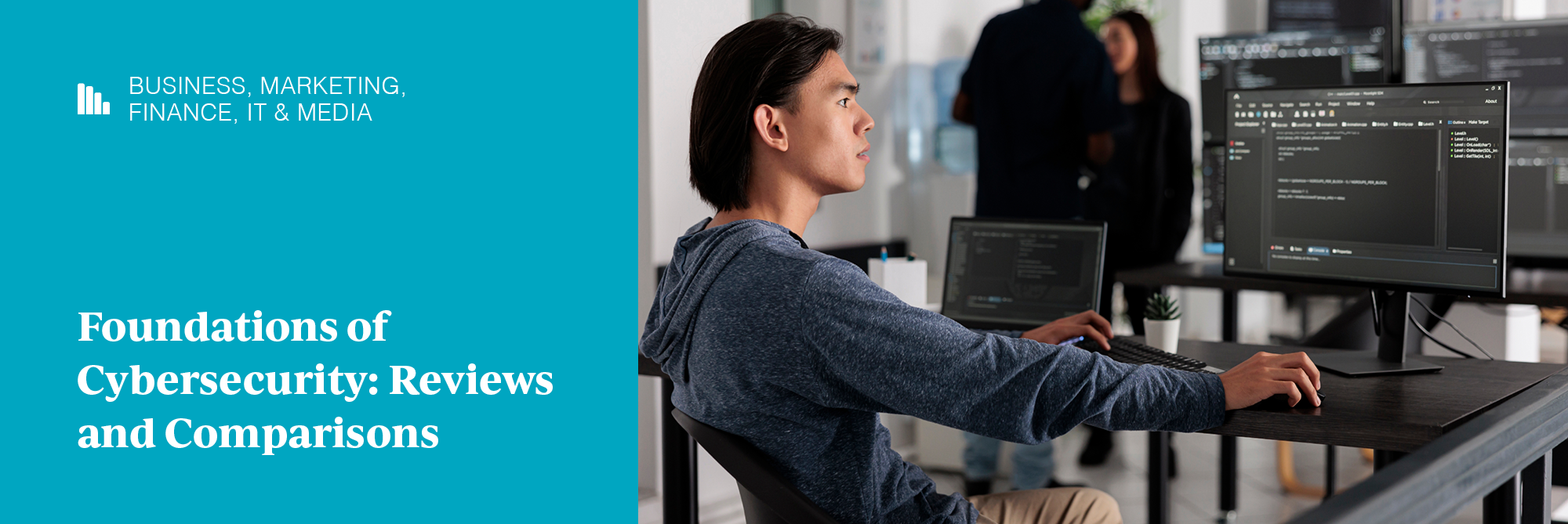High School | Computer Science
Foundations of Cybersecurity: Reviews and Comparisons
After serving as a Texas FFA state officer in 2018, Josh Witherspoon joined the iCEV team as a part-time employee for 3 years before taking on the role of content development specialist in 2022. Witherspoon holds a bachelor's degree in agricultural communications from Texas Tech University, in which his experience and proficiency in writing, marketing and CTE allow him to effectively communicate the successes of CTE educators and students and the value iCEV has to offer.
As a computer science educator, you understand that cybersecurity is a foundational concept and skill set necessary for students to be successful in the industry. After all, today’s technology-driven workforce requires individuals to understand the purpose of cybersecurity regardless of the industry students enter.
However, with the multitude of options available, choosing the right curriculum for your classroom can be quite a challenge.
As a passionate STEM and computer science curriculum provider, we’re often asked about the best cybersecurity curriculum available. In this article, you’ll discover how some of the top cybersecurity curriculum providers---CodeHS and eDynamic Learning---compare to iCEV.
After reading this article, you’ll have a better understanding of the benefits and drawbacks of each provider, as well as who the curriculum is a best fit for to make the right decision for your students.
iCEV’s Foundations of Cybersecurity Curriculum
Within iCEV’s STEM offerings educators will find the Foundations of Cybersecurity course curriculum for grades 9-12. This curriculum is designed to help students master core cybersecurity concepts in various ways, from ethics and law to digital forensic basics.
Lessons within the Foundations of Cybersecurity course include:
- Introduction to Cybersecurity
- Digital Citizenship
- Cybersecurity Ethics & Laws
- Risks of Sharing Information
- Social Engineering
- Basic Cybersecurity Concepts: Risk Management
- Basic Cybersecurity Concepts: Security & Incident Response
- Malware
- Preventing System Compromise: System Administration & Services
- Preventing System Compromise: System Protection & Awareness
- Cyber Issues: Infected Computers & Breaches
- Cyber Issues: Ransomware
- Principles of Network Operations: Network Addressing & Devices
- Principles of Network Operations: Ports, Protocols & Monitoring
- System Administration Practices
- Digital Forensics Basics
- Cryptography Basics
- Cyber Issues: Passwords & Two-Factor Authentication
- Cyber Vulnerabilities Threats & Attacks
- Network Vulnerabilities
- Internet of Things Defined
- Threats to Computer Applications
- Assessing Cybersecurity Risk
- Cyberterrorism & Counterterrorism
In a course you can expect to find pre-built lesson plans, multimedia based lessons, interactive activities, formative and summative assessments as well as other resources and materials to engage students.
What Are the Benefits of This Curriculum?
With a single subscription, you’ll receive access to iCEV’s entire STEM course library to create the most comprehensive and cohesive learning experience over multiple years. Educators also receive access to a robust learning management system, with integration options, to track student activity and report on their progress over time.
In addition, iCEV courses use engaging and varied instructional methods that create a blended learning environment in which all students can succeed. With iCEV, teachers can tailor their instruction to the needs of every student, including special populations.
iCEV’s courses are also continuously updated to meet changes in standards to ensure your students interact with the most current and relevant industry knowledge and skills for your course.
What Are the Drawbacks of This Curriculum?
While iCEV’s cybersecurity curriculum is a great fit for many classrooms, it isn’t the right solution for everyone. Educators searching for more traditional, text-based format might prefer a print-based curriculum option for their classroom rather than a digital solution.
In addition, teachers who would rather craft their own lesson plans may not use the full library of premade lesson plans available on the platform. You don’t want to pay for something you may not use.
Lastly, educators looking for a curriculum resource that focuses on a single facet of cybersecurity might consider a less comprehensive curriculum.
Who Should Consider This Curriculum?
iCEV gives students a comprehensive introduction to cybersecurity concepts and skills while offering opportunities to expand into other areas, including computer science and STEM. Through engaging multimedia content and interactive activities, your students will learn a wide variety of knowledge and skills to set them on a path to success whether they pursue a career in the industry or not.
It’s a solid choice for educators looking to teach students a variety of technological and cybersecurity skills with a comprehensive blended learning experience. It’s not for teachers who favor more traditional instruction methods with less interactivity.
CodeHS Fundamentals of Cybersecurity Curriculum
CodeHS is a computer science-specific curriculum provider and platform that offers a wide variety of resources, including the Fundamentals of Cybersecurity course curriculum. This resource is designed for students in grades 9-12 and prepares them for more advanced cybersecurity courses or certifications.
There are 11 lessons within the Fundamentals of Cybersecurity course, including:
- What is Cybersecurity?
- Digital Citizenship and Cyber Hygiene
- Project: Public Service Announcement
- Programming Fundamentals
- The ABCs of Cryptography
- Project: Classic Cipher Newscast
- System Administration
- Software Security
- Networking Fundamentals
- IT Infrastructure
- Project: Troubleshooting
This year-long curriculum option is designed for students with some exposure to computer science, but there are no specific prerequisites. In this course, students will modify existing code and run it in the browser, investigate cyber-related topics, create digital presentations, and engage in in-person collaborative exercises with classmates.
What Are the Benefits of This Curriculum?
As a digital curriculum option, CodeHS offers a robust platform with a high level of educational content, including simulations. Simulations allow students to accurately replicate what they learn using hands-on learning to test their understanding.
Another benefit of using CodeHS curriculum lies within the customization and different data configurations their gradebook offers. Teachers can select a grading category for teacher-graded or automatically graded assignments. Items that need to be manually graded populate in a review tab for the teacher to access all items needing attention.
What Are the Drawbacks of This Curriculum?
The first drawback to this option is that CodeHS access is tiered, meaning that certain features are only available to higher-tiered subscriptions. For example, a user can only print a quiz or show answer feedback to quizzes with a Pro account, whereas other providers offer non-tiered access to valuable features.
Furthermore, videos associated with the CodeHS curriculum are sometimes available from other sources, such as CNN. The videos are also housed on YouTube, which can pose issues for schools that don’t allow access to YouTube or don’t want specific sources used in the classroom.
Finally, CodeHS lacks lesson-specific activities or assignments that allow students opportunities to practice what they learned in the lesson. Lessons within CodeHS courses include a check for understanding and reflection questions. The course instead has projects throughout that cover more comprehensive topics for the preceding lessons rather than lesson-specific activities projects.
Who Should Consider This Curriculum?
Ultimately, CodeHS is a high-quality supplemental resource that offers hands-on learning opportunities for students. Through checks for understanding, reflections, and simulations, students learn both cybersecurity concepts as well as apply what they learned.
It’s a solid choice for educators looking to incorporate more hands-on learning into their classroom. It’s not for teachers looking for a curriculum resource equipped with a wide variety of activities, assessments, and other interactive materials that help students interact with what they’re learning in a variety of ways.
eDynamic Learning’s Cybersecurity 1a Foundations & 1b Defense Against Threats
eDynamic Learning (eDL) is a popular CTE curriculum provider offering digital courses for middle and high school students. Within their wide variety of course options, educators will find the two sections that make up their cybersecurity course offerings: Cybersecurity 1a: Foundations and Cybersecurity 1b: Defense Against Threats.
Units found within the Cybersecurity 1a: Foundations section include:
- Basics of Cybersecurity
- Computers and Operating Systems
- Networking Fundamentals
- Network Security
- Access Control
- Mobile Devices and Cloud Computing
- Protecting Data
- Trends and Challenges
Units in the Cybersecurity 1b: Defense Against Threats include:
- Cybersecurity Threats
- Laws, Ethics, and Digital Boundaries
- Black Hats
- Cyber Safety
- Personal Cybersecurity Inventory
- White Hat Hackers
- Incident Response, Investigations, and Digital Forensics
- Cybersecurity Careers
While these two sections must be purchased separately, they do build upon one another and contain enough materials and resources to teach an entire semester or year, depending on your instructional goals and pacing.
What Are the Benefits of This Curriculum?
There are various accessibility features, including read-aloud and translation, that make eDL a great resource to help educators meet the needs of all students. Students can select text and use the dictionary and picture dictionary features to gain an understanding of the term chosen. There’s also shadow and highlight where you can scroll through the page with a panel, which is useful for students with 504 plans or IEPs.
In addition, the course has a section when getting started that includes all the course materials: how to be successful in the class, course syllabus, required materials, course vocabulary, bibliography, and career certifications. This compilation of resources would be beneficial for a teacher when planning or for an educator new to the classroom.
Finally, eDL offers a well-organized corresponding textbook for students to use as they progress through each topic and unit. Videos, images and text callouts complement the well-rounded text, offering educators another way to engage students in their learning.
What Are the Drawbacks of This Curriculum?
One of the biggest drawbacks to eDL’s cybersecurity curriculum is that it doesn’t have a wide variety of activities and projects to allow students to synthesize and apply what they’ve learned. In addition, the few activities found in each unit lack the hands-on components that make CTE impactful. The activities and check for understanding assignments instead rely on more traditional methods to allow students to interact with content.
When educators view the eDL platform, you’ll notice that there are no self-grading options for activities or quizzes, only for assessments. By lacking this feature, educators must manually grade these smaller assignments, taking valuable time away from students or cutting into after-school time.
Who Should Consider This Curriculum?
eDynamic Learning is best suited for an asynchronous learning environment. Educators looking to assign their students digital coursework and manage the course digitally will likely be successful with this option as it has less variety in how students engage with coursework.
On the other hand, if you’re an educator looking to create a blended learning environment using a variety of instructional methods and interactive activities, you might be disappointed in this curriculum option.
Which Cybersecurity Curriculum Is Best For My Students?
Deciding on the right cybersecurity curriculum provider can be a challenge, with many factors to consider. To ensure you’re making the best decision for your classroom and students, it is of utmost importance that you think about the needs of your students and your own instructional goals.
Any of these curriculum providers can help you ensure your students have a solid understanding of cybersecurity in or outside of the computer science industry.
However, if you’re looking for a comprehensive cybersecurity resource to meet your standards and set your students on a path for success, iCEV is a strong choice.
If iCEV sounds like like it could be right for your students and classroom, sign up for a free trial. You’ll gain instant access to the iCEV platform and curriculum so you can decide if it's truly a good fit for your students.


